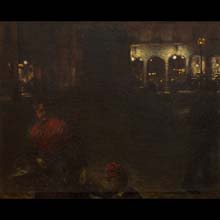
material: oil on board
dimensions: 40 × 50 cm
description: Aleksander Gierymski stayed in Munich between 1888 and 1890. He was attracted to the nightlife of the metropolis and the expressive atmosphere of night or twilight. Based on plein-air studies, he painted a series of urban nocturnes, in which he explored formal problems resulting from sharp contrasts between light and shadow, the effect of illuminating darkness with the artificial light of street gas lamps. The painting in question, showing a night view of the Wittelsbach square, is an oil study for the final composition, currently in the collection of the National Museum in Warsaw. The classical Wittelsbach square in Munich, designed by Leo von Klenze, is one of the most beautiful urban sites in the capital of Bavaria. The picture shows a part of a street with skilfully rendered traffic. The figures of a woman and a child, visible in the foreground, as if captured by a photo camera, are disappearing in the dark. The landscape is shrouded in a misty and wet aura, and the elements of architecture are illuminated by the faint glow of street lamps. Anecdote is of no significance here, as the artist is mainly preoccupied with the purely formal problem – subtle gradations of colours and capturing the light diffused in shadows and half-shadows. Gierymski avoids his characteristic meticulous finish of detail; he builds form using colour without paying attention to the accuracy of drawing. Delicate gradations of dark colours have been relieved by red accents visible on the clothes of passers-by. The technique employed by the artist well conveys the expressive quality of the night, making different parts of the view and contours less pronounced. Despite the success he achieved there, Gierymski decided to leave Bavaria and go to Paris in the middle of September 1890. Aleksandra Krypczyk
exposition: The Gallery of 19th Century Polish Art in Sukiennice,
The Cloth Hall, 1, Main Market Square
key: Realism, polish impressionism, beginnings of symbolism >>>
dimensions: 40 × 50 cm
description: Aleksander Gierymski stayed in Munich between 1888 and 1890. He was attracted to the nightlife of the metropolis and the expressive atmosphere of night or twilight. Based on plein-air studies, he painted a series of urban nocturnes, in which he explored formal problems resulting from sharp contrasts between light and shadow, the effect of illuminating darkness with the artificial light of street gas lamps. The painting in question, showing a night view of the Wittelsbach square, is an oil study for the final composition, currently in the collection of the National Museum in Warsaw. The classical Wittelsbach square in Munich, designed by Leo von Klenze, is one of the most beautiful urban sites in the capital of Bavaria. The picture shows a part of a street with skilfully rendered traffic. The figures of a woman and a child, visible in the foreground, as if captured by a photo camera, are disappearing in the dark. The landscape is shrouded in a misty and wet aura, and the elements of architecture are illuminated by the faint glow of street lamps. Anecdote is of no significance here, as the artist is mainly preoccupied with the purely formal problem – subtle gradations of colours and capturing the light diffused in shadows and half-shadows. Gierymski avoids his characteristic meticulous finish of detail; he builds form using colour without paying attention to the accuracy of drawing. Delicate gradations of dark colours have been relieved by red accents visible on the clothes of passers-by. The technique employed by the artist well conveys the expressive quality of the night, making different parts of the view and contours less pronounced. Despite the success he achieved there, Gierymski decided to leave Bavaria and go to Paris in the middle of September 1890. Aleksandra Krypczyk
exposition: The Gallery of 19th Century Polish Art in Sukiennice,
The Cloth Hall, 1, Main Market Square
key: Realism, polish impressionism, beginnings of symbolism >>>












